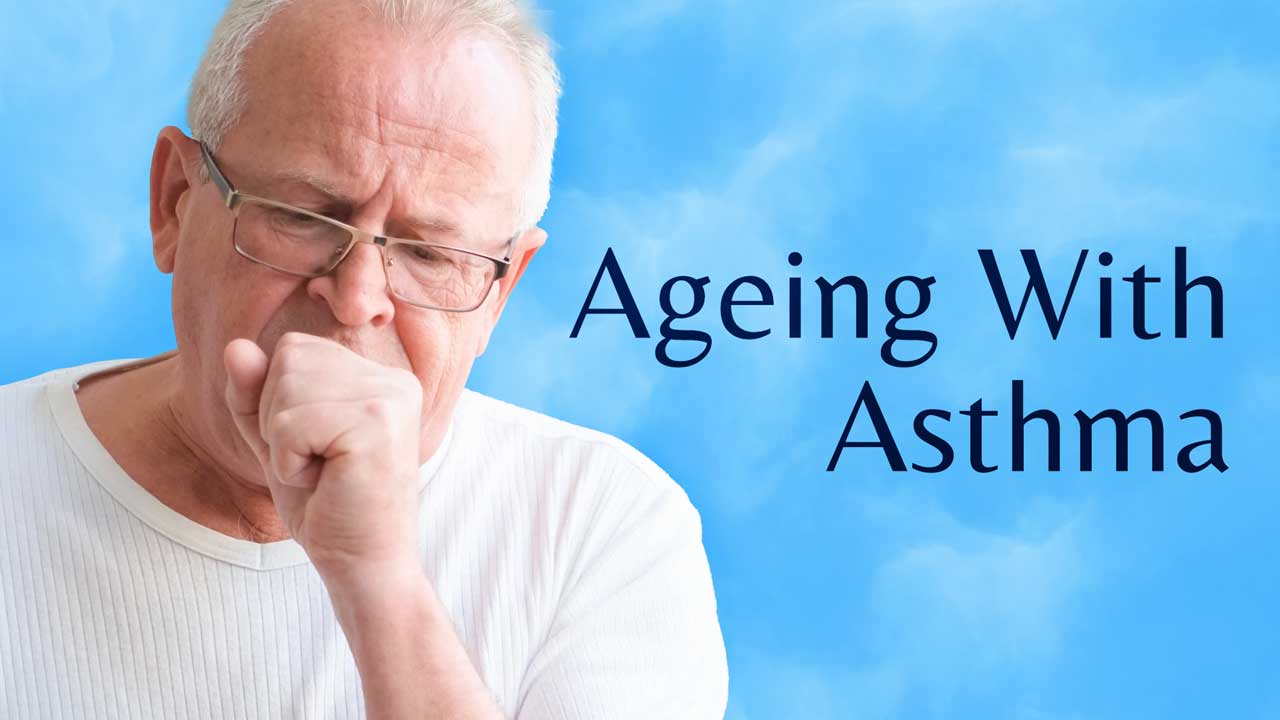In 2021, 78% of all deaths with asthma as an underlying cause in Australia were older adults aged over 65 (AIHW 2023).
Sadly, asthma is often misdiagnosed and overlooked in older adults, despite being just as common as it is in younger populations (and even more common among those aged over 75) (Burdon 2015; AIHW 2023).
About 10% of Australians aged over 65 and 14% of those aged over 75 have asthma (AIHW 2023).
Asthma is a manageable condition but impedes on quality of life and presents significant risks to older adults, especially those who are underdiagnosed or undertreated (Dunn et al. 2018).
Lung Changes With Ageing
Lung function reaches peak performance at around the age of 20-25 before beginning to gradually decrease. While this is a natural decline, untreated asthma can accelerate this process (NACA 2013).
Specific effects of ageing on the lungs include:
- A decline in peak airflow and gas exchange
- A decline in measures of lung function (e.g. vital capacity)
- Weakening of respiratory muscles
- Decreased effectiveness of lung defence mechanisms.
(Dezube 2023)
Risk Factors for Adult-Onset Asthma
- Weight gain or obesity
- Smoking
- Exposure to irritants
- Pharmaceuticals
- Environmental pollutants
- Rhinitis
- Chronic sinus symptoms
- Respiratory tract infections
- New habitual snoring
- Psychological stress.
(Burdon 2015; Pulmonology Advisor 2019)
Approximately 10% of adult-onset asthma cases are caused by occupational exposure to irritants (Burdon 2015).
Why Are Older Adults Often Undiagnosed?

Approximately half of those aged over 75 with asthma are undiagnosed. People in this age group often assume their symptoms are simply related to ageing or are being caused by other factors such as weight or lack of fitness. As a result, they are less likely to report their symptoms to a doctor (NACA 2013).
Furthermore, asthma symptoms can be mistakenly attributed to other conditions that affect older adults, especially if they are common and non-specific (e.g. a cough) (Pulmonology Advisor 2019).
Compared to younger people, older adults also have a higher prevalence of non-asthma conditions that cause shortness of breath (e.g. chronic obstructive pulmonary disease (COPD) and heart failure), which makes differential diagnosis challenging (Nyenhuis 2023).
Older adults may also be less likely to report symptoms due to:
- Denial
- Fear
- Cognitive impairment
- Depression
- Social isolation
- Poor health literacy.
(Pulmonology Advisor 2019)
Asthma Symptoms in Older Adults
The symptoms of asthma are generally the same regardless of age. If an adult over 65 is experiencing any of the following symptoms, they should seek medical advice:
- Shortness of breath or breathlessness
- Chest tightness
- Wheezing.
(NACA 2013)
Comorbidities in Older Adults With Asthma
More than 70% of people over 45 who have asthma also have at least one comorbidity. Many have more than two (AIHW 2023). Some of the most common comorbidities include:
| Comorbidity | % of people (over 45) with asthma who are affected | % of people (over 45) without asthma who are affected |
| Arthritis | 42% | 26% |
| Back problems | 33% | 23% |
| Mental and behavioural conditions | 20% | 11% |
| Chronic obstructive pulmonary disease (COPD) | 14% | 1.9% |
| Osteoporosis | 31% | 22% |
| Mental and behavioural conditions | 12% | 7.6% |
(AIHW 2023)
It’s clear that these conditions are significantly more prevalent in people over 45 with asthma than those without asthma.
In addition to the conditions above, people over 45 with asthma may also experience:
- Cancer
- Diabetes
- Kidney disease
- Allergic rhinitis
- Obstructive sleep apnoea
- Mental illness
- Nasal polyps
- Gastro-oesophageal reflux disease (GORD).
(AIHW 2023)
Adults with asthma are also 1.8 times more likely to be obese than those without (AIHW 2023).
Managing Asthma as an Older Adult
Older adults might have difficulty managing asthma because they:
- May be less responsive to typical asthma treatments due to altered airways and systemic inflammation
- May have difficulty managing a complex medication regimen
- Are more likely to experience side effects from asthma medications
- May also be taking medications for comorbidities, increasing the risk of medication interactions
- May have difficulty using their hands due to conditions such as arthritis, which can cause challenges (e.g. being unable to connect their puffer to a spacer)
- May have difficulty learning and practicing correct inhaler use due to factors such as cognitive impairment.
(Pulmonology Advisor 2019; Nyenhuis 2023)
In order to effectively manage their asthma, older adults should:
- Refrain from smoking
- Avoid irritants that trigger symptoms
- Seek advice on the most appropriate treatment method (puffer or nebuliser) and how to properly use it
- Follow their asthma action plan
- Inform their general practitioner about any new medications
- Seek guidance and advice when required.
(NACA 2013)

Conclusion
Asthma in older adults can be challenging to diagnose and manage, and poses significant risks. Therefore, it is important to ensure older adults report any asthma symptoms so that their condition can be addressed appropriately.
Test Your Knowledge
Question 1 of 3
Fill in the gap: Adults over 45 with asthma are [...]% more likely to have arthritis than those without asthma.
Topics
References
- Australian Institute of Health and Welfare 2023, Chronic Respiratory Conditions: Asthma, Australian Government, viewed 1 August 2023, https://www.aihw.gov.au/reports/chronic-respiratory-conditions/asthma-1
- Burdon, J 2015, ‘Adult-onset Asthma’, Australian Family Physician, vol. 44 no. 8, viewed 1 August 2023, https://www.racgp.org.au/afp/2015/august/adult-onset-asthma/
- Dezube, R 2023, Effects of Aging on the Respiratory System, MSD Manual, viewed 2 August 2023, https://www.msdmanuals.com/home/lung-and-airway-disorders/biology-of-the-lungs-and-airways/effects-of-aging-on-the-respiratory-system
- Dunn, RM, Busse, PJ & Wechsler, ME 2018, ‘Asthma in the Elderly And Late-Onset Adult Asthma’, Allergy, vol. 73, no. 2, viewed 2 August 2023, https://onlinelibrary.wiley.com/doi/full/10.1111/all.13258
- National Asthma Council Australia 2013, Asthma & Older Adults, NACA, viewed 2 August 2023, https://d8z57tiamduo7.cloudfront.net/resources/asthma-older-adults.pdf
- Nyenhuis, SM 2023, Diagnosis and Management of Asthma in Older Adults, UpToDate, viewed 2 August 2023, https://www.uptodate.com/contents/diagnosis-and-management-of-asthma-in-older-adults
- Pulmonology Advisor 2019, Asthma in the Elderly: Important Considerations for Diagnosis and Treatment, Pulmonology Advisor, viewed 2 August 2023, https://www.pulmonologyadvisor.com/home/topics/asthma/asthma-management-and-treatment-considerations-in-elderly-patients/

